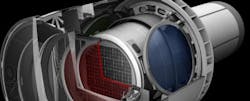At the Department of Energy's SLAC National Accelerator Laboratory (Menlo Park, CA), plans for the 3200-megapixel centerpiece of the camera for the Large Synoptic Survey Telescope (LSST) have reached a major milestone: the plans have received key "Critical Decision 2" approval from the U.S. Department of Energy (DOE).
The LSST, to be constructed in Chile, will have an 8.4 m primary mirror and will operate at wavelengths from 320 to 1060 nm. Composed of 189 tiled 4k x 4k CCD sensors, the camera itself will be cryogenically cooled to -100°C and will have a readout time of 2 s or less.
"This important decision endorses the camera fabrication budget that we proposed," says LSST director Steven Kahn. "Together with the construction funding we received from the National Science Foundation in August, it is now clear that LSST will have the support it needs to be completed on schedule."
Science operations are scheduled to begin in 2022 with LSST taking digital images of the entire visible southern sky every few nights from atop a mountain called Cerro Pachón in Chile. It will produce the widest, deepest and fastest views of the night sky ever observed.
6000 terabytes per year of image data
LSST will generate a vast public archive of data (approximately 6000 terabytes per year) that will help researchers study the formation of galaxies, track potentially hazardous asteroids, observe exploding stars, and better understand dark matter and dark energy.
"The telescope is a key part of the long-term strategy to study dark energy and other scientific topics in the United States and elsewhere," says David MacFarlane, SLAC's director of particle physics and astrophysics. "SLAC places high priority on the successful development and construction of the LSST camera, and is very pleased that the project has achieved this major approval milestone."
The LSST team can now move forward with the development of the camera and prepare for the "Critical Decision 3" review process next summer, the last requirement before actual fabrication of the camera can begin.
Components of the camera, which will be the size of a compact car and weigh more than 3 tons, will be built by an international collaboration of labs and universities, including DOE's Brookhaven National Laboratory, Lawrence Livermore National Laboratory, and SLAC, where the camera will be assembled and tested.

